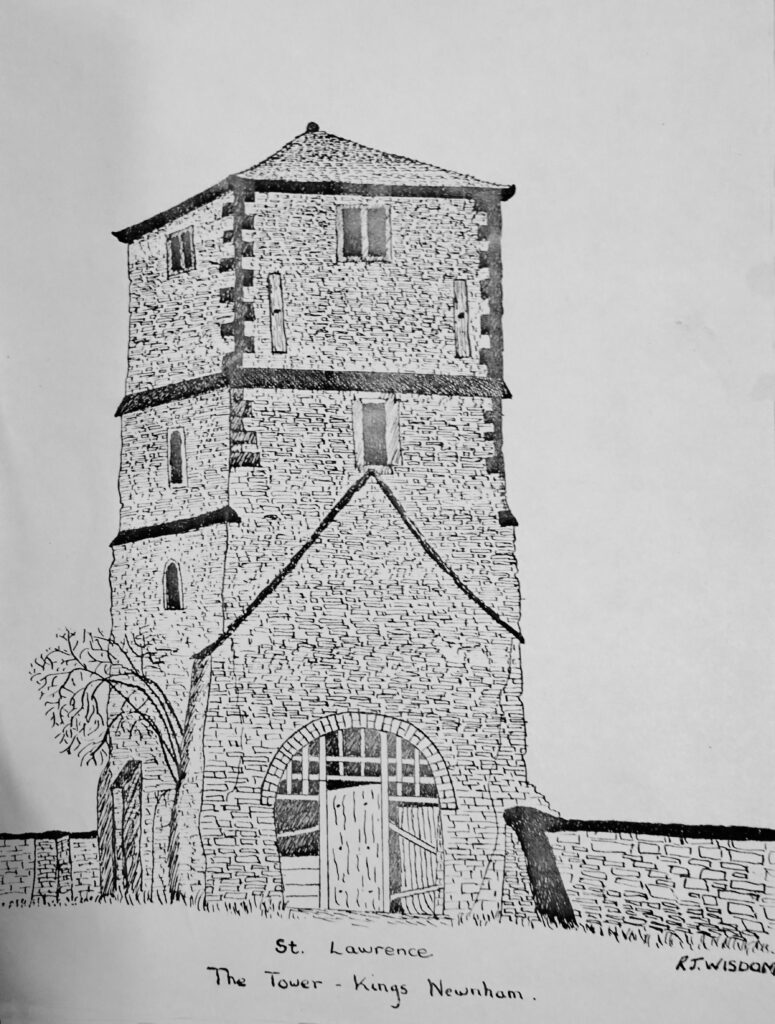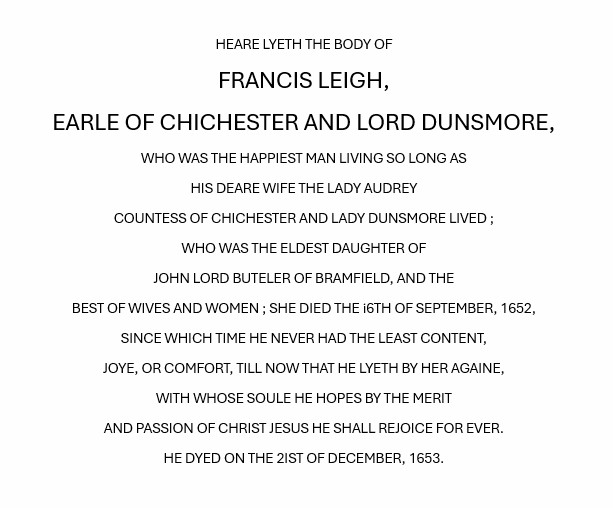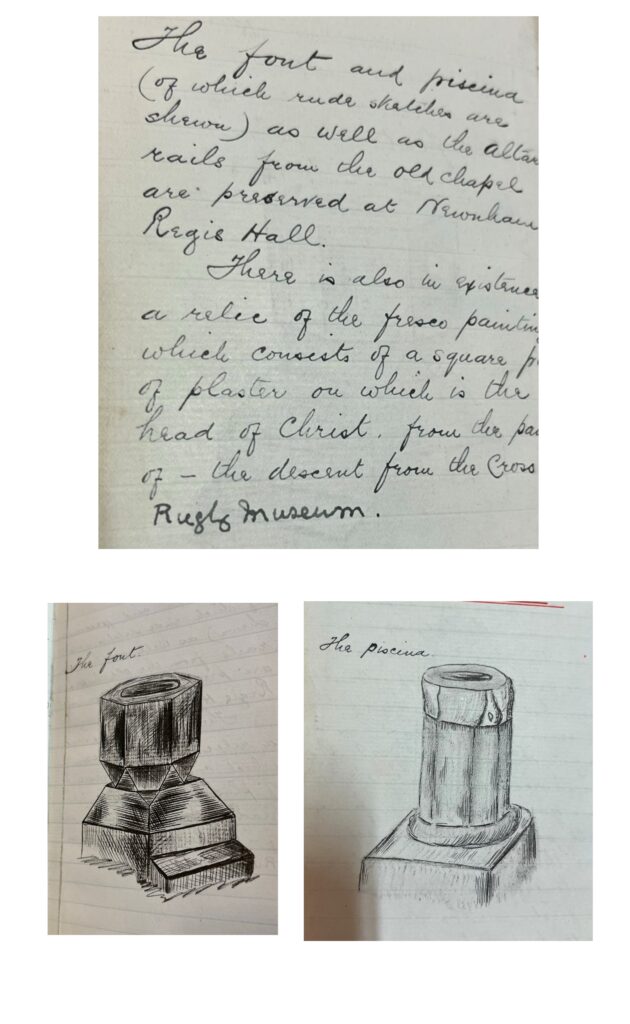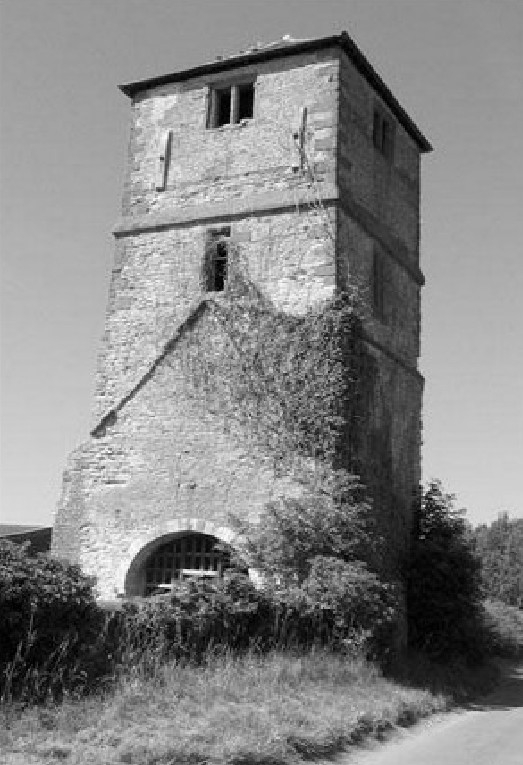The tower of St Laurence’s Church dominates the valley of the river Avon for several miles. It is all that remains of the 12th Century Church of St Laurence, once the parish church of King’s Newnham.

According to the Victoria County History The church was still in use in 1730, when it was noted “The seats are very handsome; on the walls of the Church are painted in fresco the four Evangelists in full proportion, on the northside wall of the Chancell, the offerings of the wise men, and on the south wall, the taking down of our Saviour from the Cross.”
The eminent historian William Dugdale (1605-1686) was born in Warwickshire and produced a notable reference work called “The Antiquities of Warwickshire” first published in 1656. It is written in the style and language of those times, but clearly has more information about St Laurence’s and the Parish. One of the remaining projects for this archive is to look more closely at Dugdale’s words on the two villages, as they are regarded by later historians as being extremely valuable.
In the 17th century it became the family chapel of the Leigh Family, the Lords of the Manor, and was handsomely decorated. During the last decade of the 18th century it was visited by Samuel Ireland, who recorded it in his 1795 publication 18th Century is Picturesque Views on the Warwickshire, or Upper Avon. He noted that “the body of the venerable chapel of this place is now by order of its proprietor taking down, but the tower, I am informed, is to remain: the chapel has been long in disuse. In pulling down this edifice, the pavement giving way, not far from the surface a perfect skeleton, supposed to have been that of the founder, was discovered, and not far from it a seal. The altar of this church was decorated with some good paintings in fresco, well preserved, which seem to bear the character and style of painting of the time of James I. The designs are made from subjects in the New Testament, and in their manner are not unlike those of Reubens, but have more the air of the Italian school.” As discussed, the demolition did leave only the tower standing, but it appears no further attempts were made to consider the state of the graveyard at that time.
It was the final resting place of the Cavalier Sir Francis Leigh, Earl of Chichester, whose coffin, along with those of close family members, was disinterred in the 1850s revealing remarkably well-preserved bodies. Also disinterred was the body of a decapitated man who was most likely a casualty of the Civil War, serving in Sir Francis’s regiment. These findings were discussed during a 1921 tour of the area by local historians – detailed here. The inscription found on the coffin of Sir Francis Leigh was thus:

Along with the various reports that were published of the work to excavate the graves and then reseal them appropriately, there was a certain amount of opposition to this being carried out – as evidenced in a poem written by a member of the Boughton-Leigh family, detailed here.
A second poem, in a similar vein, was published shortly after the graves were excavated, this one called “Lady Audrey Leigh”, and written by Patrick Scott, published in 1853 – that poem can also be downloaded via this link.
See here for more details on St Laurence Tower
There is some debate on the spelling of the saint’s name – both “Laurence” and “Lawrence” are in common use, and older history publications do not provide additional clarity.
In 1937 the Midland Daily Telegraph carried a report on the church at that time. The key section is transcribed below, as the original article can be rather difficult to read,
St Laurence’s Tower—all that remains of a magnificent little church formerly set in a countryside renowned for its religious fervour – stands on farm property. Its grey walls arc flush with the highway leading from Bretford to the little collection of cottages that forms the King’s Newnham hamlet, and just now and again a passer-by will pause for a few moments to examine the old stones. But not all whose journeying is thus briefly halted stay long enough to study the restored Norman arch that leads to the interior, or to find out about the rich history that marks the massive pile as a remarkable relic with a strange tale to tell.
Why Church Was Destroyed
And few indeed are those who know about the mummified bodies found at King’s Newnham the best part of a century ago – a happening which would have made a first-class news story had it occurred to-day – or about the ghost that King’s Newnham shared with a number of other places in the district.
There is a certain obscurity about the early history of the church, but it is believed to have been erected by the Monks of Kenilworth, and that it eventually became the private chapel of the Manor Hou>e since it stood within the park.
Writing of the desecration of the church, an authority reveals that the chapel became dilapidated when the Lords of the Manor ceased to reside on the estate, and about the year 1745 the Steward of the estate ordered its demolition. This was without the sanction of the owner or the Bishop, and the latter only heard of it in time to preserve the portion of the tower which still remains.
It was over a hundred years later- in 1852—when Lord John Scott, a big landowner in the district, who was beloved of the whole neighbourhood, decided to have the site of the church cleared and fenced in. And it was during the operations that some grim and yet very wonderful discoveries wero made.
Tomb of Lady Audrey Leigh
Covered by a wooden shelter with a leaden roof, and set among an overgrown area of land that was once the nave of the old church, there remains to this day the tomb of Lady Andrey Leigh, daughter of the Earl and Countess of Chichester, whose mummified remains, as perfect as when they were interred over two centuries before, were found during the excavations.
Discoveries made by those workmen of 1852 were most sensational in character. During the first part of their excavations they came across a great many bones and skeletons from which the coffins had crumbled away, but at a deeper level they discovered a leaden coffin. quite perfect, but without date or inscription of any kind.
Beheaded But Embalmed
When the top was cut and rolled back there was diffused an overpowering aromatic smell, and within an inner coffin was found the body of a man carefully embalmed, with heaps of rosemary and aromatic leaves piled over him. An examination revealed that the man had been beheaded, his head being separately wrapped in linen.
His wrists and thumbs were bound together with black ribbon, and the only clue to his identity, but one which never led to his name being discovered, was the letters “T.B.” worked in black silk upon his linen shirt.
Nearer the chancel end of the church were found four similar coffins, each with an inscription, placed side by side. In one was the body of Francis, Earl of Chichester and Lord Dunsmore, 1653; in the next that of Audrey, Countess of Chichester, 1652; and then the body of Lady Audrey Leigh. their daughter, the date 1640 being on the coffin lid. The fourth coffin contained Sir John Anderson, a son of Lady Chichester by her first husband.
Artefacts Discussions in the Nineteenth Century
A discussion about the fate of the contents of St Laurence’s was included in the well respected local history book by W O Wait – Rugby Past and Present in 1893. Further reviews are considering whether any of the artefacts mentioned are still in existence – notably the fragments of frescoes.
Artefacts Discussed early in Twentieth Century
At the start of the twentieth century the remains of St Laurence’s Tower were in the grounds of Newnham Hall, which had been occupied by the Brierly family for many years. A family relative, John Pearson, noted around 1900 the artefacts from St Laurence’s Church that were held at Newnham Hall – in particular the font and piscina, and he provided a drawing of these artefacts.

Account of 1852 Discoveries
An account of the discoveries which appeared in “Notes and Queries” in September, 1852, being written by one who was on the spot, tells graphically of how the body of Lady Audrey—dead for over two hundred years—came to light.
“We opened the coffin of Lady Audrey Leigh,” he wrote, “and found her perfectly embalmed and in entire preservation; her flesh quite plump as if she were alive, her face very beautiful, her hands exceedingly small and not wasted. She was dressed in fine linen, trimmed all over with old point lace laid flat against her forehead.
“She looked exactly as if she were lying asleep, and seemed not more than 16 or 17 years old. Her beauty was very great, even the eye lashes and eye-brows were quite perfect, and her eyes were closed. No part of her face or figure was at all fallen in. She had ear-rings in her ears – black enamelled serpents.”
Near where the altar had been was found yet another coffin containing the perfectly preserved body of Dame Marie Browne, a sister of Lord Chichester. In only one case—that of Lady Chichester—was it found that the embalming process had failed. Here only a skeleton was found, but her hair, which was of a rich auburn shade, was as fresh and as soft as though the woman still lived.
Lord John Scott afterwards had the whole of the coffins reinterred, and over the grave of the young Lady Audrey he had placed a stone with a beautiful brass plate designed in the style of the period and bearing as an inscription a copy of the breastplate on the coffin. Beneath the wooden cover referred to above, this is still visible, and it is of interest, to note that the young lady buried below, despite her tender years, is described as “Mrs Audrey Leigh.”
The above words were echoed in a story published in 1939 in the Midland Daily Telegraph (the forerunner of the Coventry Evening Telegraph). The story included thoughts about the initial destruction of St Laurence’s – thus:
There is a certain obscurity about the early history of the church, but it Is believed to have been created by the Monks of Kenilworth, and that it eventually became the private chapel of the Manor House since it stood within the park.
Writing of the desecration of the church, an authority reveals that the chapel became dilapidated when the Lords of the Manor ceased to reside on the estate, and about the year 1745 the Steward of the estate ordered its demolition. This was without the sanction of the owner or the Bishop, and the latter only heard of it in time to preserve the portion of the tower which still remains.
It was over a hundred years later- in 1852—when Lord John Scott, a big landowner in the district, who was beloved of the whole neighbourhood, decided to have the site of the church cleared and fenced in. And it was during the operations that some grim and yet very wonderful discoveries were made.
Covered by a wooden shelter with a leaden roof, and set among an over grown area of land that was once the nave of the old church, there remains to this day the tomb of Lady Audrey Leigh, daughter of the Earl and Countess of Chichester, whose mummified remains, as perfect as when they were interred ever two centuries before, were found during the excavations.
Lord John Scott afterwards had the whole of the coffins reinterred, and over the grave of the young Lady Audrey he had placed a stone with a beautiful brass plate designed in the style of the period and bearing as an inscription a copy of the breastplate on the coffin. Beneath the wooden cover referred to above, this is still visible, and it is of interest, to note that the young lady buried below, despite her tender years, is described as “Mrs Audrey Leigh.”
A further press article about the church appeared in the Rugby Advertiser in August 1963 with further thoughts on the church prior to the demolition.
King’s Newnham church was dedicated to St Laurence, and stood a quarter of a mile from the village. the village had been declining ever since the end of the sixteenth century, but in 1730 the church was still intact and in regular use. It is said to have had very handsome seating, and it was notable for its wall frescoes depicting the Four Evangelists, the Offerings of the Wise Men. and the Descent from the Cross.
About the middle of the eighteenth century the church became dilapidated, and the roof fell in. and in 1795 the walls were largely demolished by the steward of the manor without the permission of the proprietor. Portions of the walls were still standing a century later, for a sketch dated 1892 shows some ruined walling with a traceried window, but all has now vanished with the exception of the tower.
Further work continues to establish the location of any remnants of the church.

